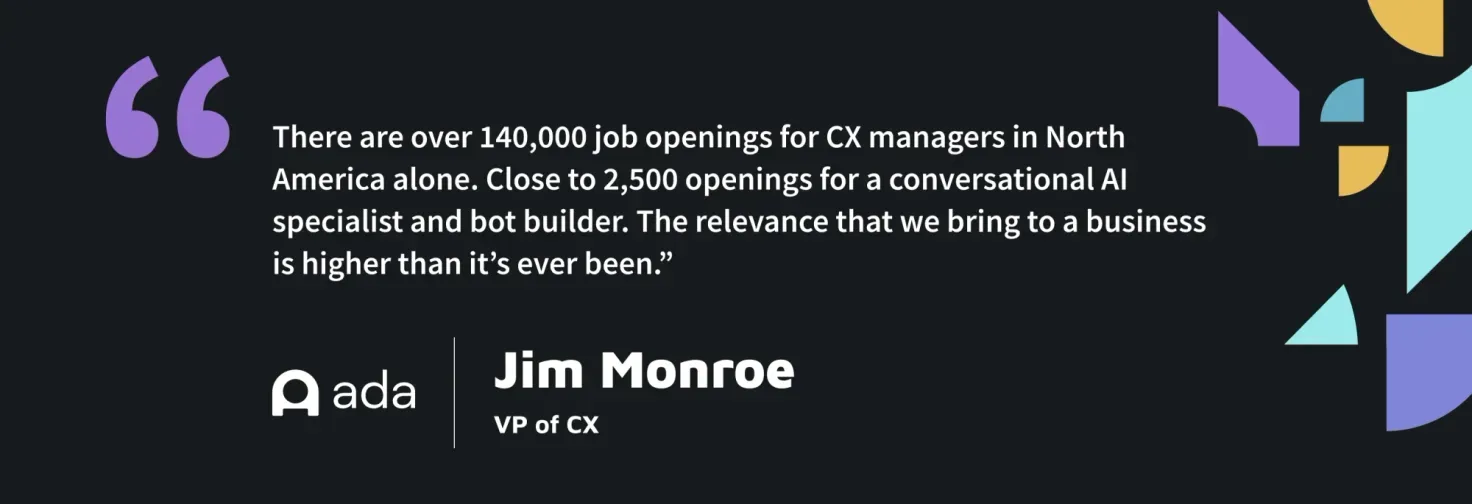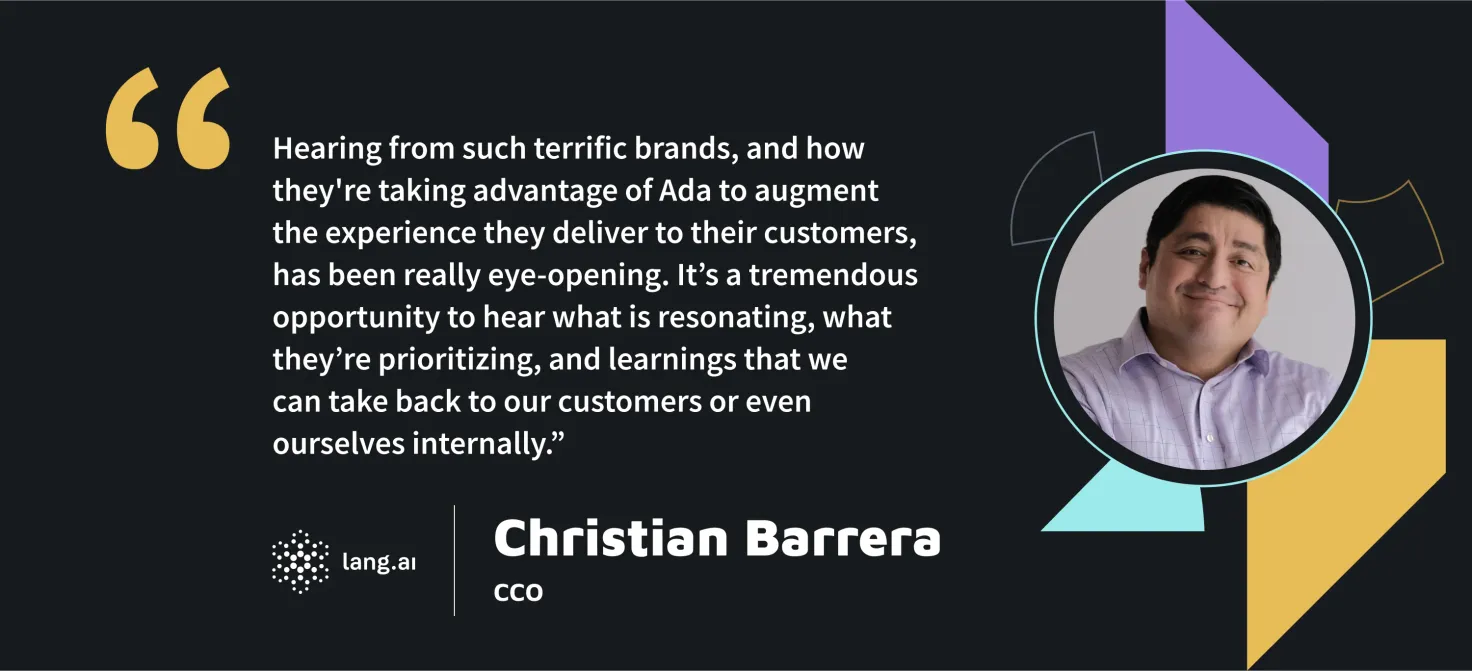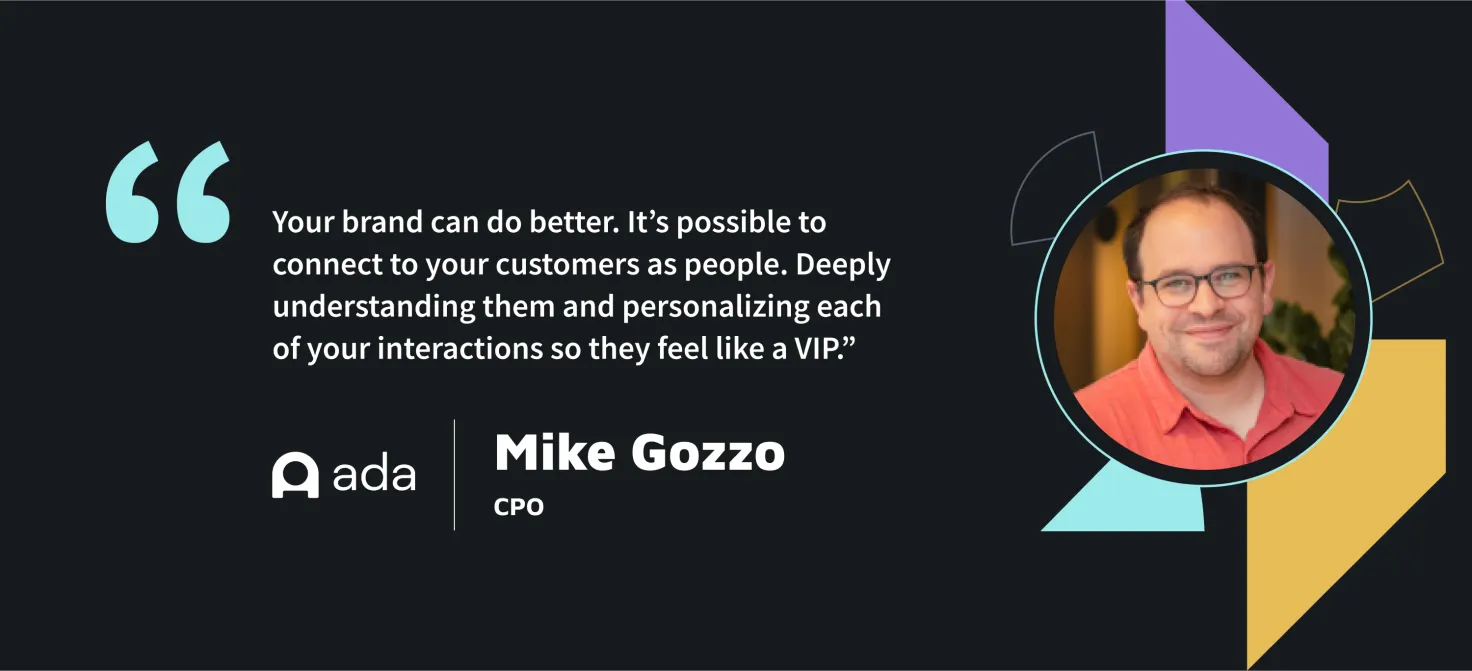
how to prioritize tech stack investments for AI customer service
Learn how to invest in systems that boost AI performance, CSAT, and ROI, without bloating your customer service tech stack.
Learn More

The first ever in-person Ada Interact has wrapped, and we’re riding high on the connections we made, the lessons learned, and the overall enthusiasm inspired by the event.
For many of us, an industry-shifting declaration remains top of mind: in the very near future, every company will be an AI company. Each powerhouse speaker and lively panel discussion told this story of a new era — one where AI drives CX and CX drives business.
This shift is already underway. The one-day event offered practical how-tos for brands looking to power VIP experiences, conversations with brands mastering the art of automated interaction, and we even offered hands-on experiences in Ada’s platform to show you how it’s done.
Regardless of which sessions attendees chose to explore, the lesson of Ada Interact shone through: for brands to become an AI company, they need the right people, the right technology, and the right strategy.
For those of you who couldn’t join us, in-person or virtually, and are looking for a quick highlight reel, you’re in the right place. Let’s get right into it.
The fact that customers prefer the path of least resistance is now common sense. That means no more burying your live chat. No more hiding your phone number. No more wait times.
By the end of this decade, brands should expect to be engaging with their customers 10x more, minimum, insisted Ada’s Co-founder and CEO Mike Murchison in his opening keynote. Simply put, CX makes or breaks a brand. Your customers are holding a magnifying glass to every interaction they have with you. As for the brands that choose to ignore this shift in customer behavior and expectation? They’ll be the Blockbusters of tomorrow.
This inevitably changes how organizations will operate internally. Today’s automation teams are akin to digital teams in the 90s, and their impact is going to grow. AI transformation of your CX starts with the right people — empowering customer-centered decision-makers across the organization. Their impact will reach billions around the world.
Jim Monroe, Ada's VP of CX, began his keynote with some interesting insight into how your customer-facing teams fit into the AI-driven future of CX. This AI transformation is nothing to fear. In fact, it offers broader opportunities for CX experts to become leaders — and even reach C-Suite status.

With the right AI-powered automation platform, a brand can capture and analyze customer data in one place, giving CX leaders an advantage over the competition. They can optimize CX quickly and effectively, boosting customer satisfaction and engagement. And who better to do this than the people who talk to your customers every day?
But there are a few considerations Jim says brands need to keep in mind when structuring a CX team for an AI-driven future:
In the afternoon, we found out how the Intuit Mailchimp team successfully implemented conversational AI at the forefront of their CX. The full scoop was reserved for our in-person attendees, but we can give you a few pointers from the conversation between Bronwyn Smith, Ada’s SVP of Operations, and Sarah Ricketts, Intuit Mailchimp’s Director of Business Solutions.
To get buy-in across the organization, Sarah and the team looked for where and how automation can add the most value to the brand. And like Jim advised, they started lean to test out specific use cases.
Now, Sarah and her team go beyond “basic functionality” to power their best-in-class CX. They flip the pyramid on its head, and anticipate their customers’ next action with personalized, proactive automation (instead of a reactive-based approach to answering questions as they come into the chat) — scaling up and out. And in doing so, they’ve turned CX from a cost center to a value-add, where more volume = more revenue.

But as we learned throughout the day, winning CX isn’t possible without the right technology to get you there.
So we’ve learned how brands can best build teams and leverage the customer experience for an AI-driven future. But many attendees were eager to learn the part technology plays.
According to Mike Gozzo, Ada’s Chief Product Officer, enterprises need automation technology that:
In solving the toughest technology problems facing brands today, Mike’s learned that the technology behind your CX requires deep and out-of-the-box integrations with all the tools you have in place. This makes it easy for you to tie together data, context, and knowledge from across your entire organization.

Zendesk’s SVP of Sunco Labs, Matt Price, joined Mike on stage to place their bets on the future of CX. They discussed recent advancements in conversational AI, and how they will radically change the CX landscape going forward. In the end, they went all-in on automation, revealing how to navigate this change to ensure your CX strategy is set up for long-term success.
The need to become an AI company is ultimately going to be driven by your customers, Mike asserted. This means digitizing and automating everywhere customers prefer to interact with you — in new channels and legacy ones. Despite many predicting the “death of offering customer support over the phone,” 60% of our customers' contact volume still comes over the phone.
Then, Mike revealed Ada’s most exciting upcoming product launch: Voice. Cue the confetti!
To be sure, nothing in the business world is done well without the right strategy. And we learned why this is crucial to becoming an AI company.
In the final keynote, Jessica Popp, Ada’s Chief Technology Officer, took us through the strategy brands need underpinning their AI transformation. First, you need to solve for three things:
This begs the question for many companies: to build conversational AI internally or to buy? Jessica made a compelling argument in favor of buy. A seasoned vet in the space of AI-building, Jessica’s been down the build road before. She took us through the scenario in detail.
As Jessica outlined, building in-house results in the focus being stuck on managing the solution. In the end, you likely won’t have the capacity, budget, or skillset to build, maintain, and run the solution over time. You’ll over-engineer the wrong problem rather than simply capturing and analyzing the data you need to continue to optimize your CX.
Ultimately, what brands should really be doing is driving outcomes. You need a solution that will scale with you, be resilient, and provide the technology you need to serve your customers anywhere, anytime.

At this point, many of the attendees were wondering how one of the pros has successfully implemented an AI-driven CX strategy. In one of the afternoon panels, we were joined by Hollis Donaldson, VP of Operations at Fanatics Betting & Gaming. Hollis guided us through their process, from build vs. buy considerations, to vendor evaluation, to the strategy behind their long-term partnership with Ada.
Talk about pulling back the curtain. This session gave attendees a clear cut path to the how behind the why.
In the afternoon, attendees were given three tracks to choose from: in-depth panel discussions on the future of automation, conversations with customers putting automation into action, and interaction labs that let attendees poke around in Ada’s platform and put together a roadmap for their AI strategy.

Along with our conversations with Intuit Mailchimp, Zendesk, and Fanatics Betting & Gambling, we learned how leading brands like 8x8 and BFA are future-proofing their CX and scaling operations for any economic condition with automation. Vox Mobile’s COO, Ron Pollock, uncovered how they drove adoption of automation to new channels, improving CX while reducing dependency on more costly, inefficient channels. And we spoke to Wendy Collins, Chatbot Manager at DAZN, to find out how they serve an international customer base with Ada.
For those of us that like to get our hands dirty and learn by doing, the afternoon also offered “Interaction Labs.” The interactive experiences allowed attendees to collaborate with their peers, ideate on solutions for shared business challenges, and even access their own personal demo environment of Ada.